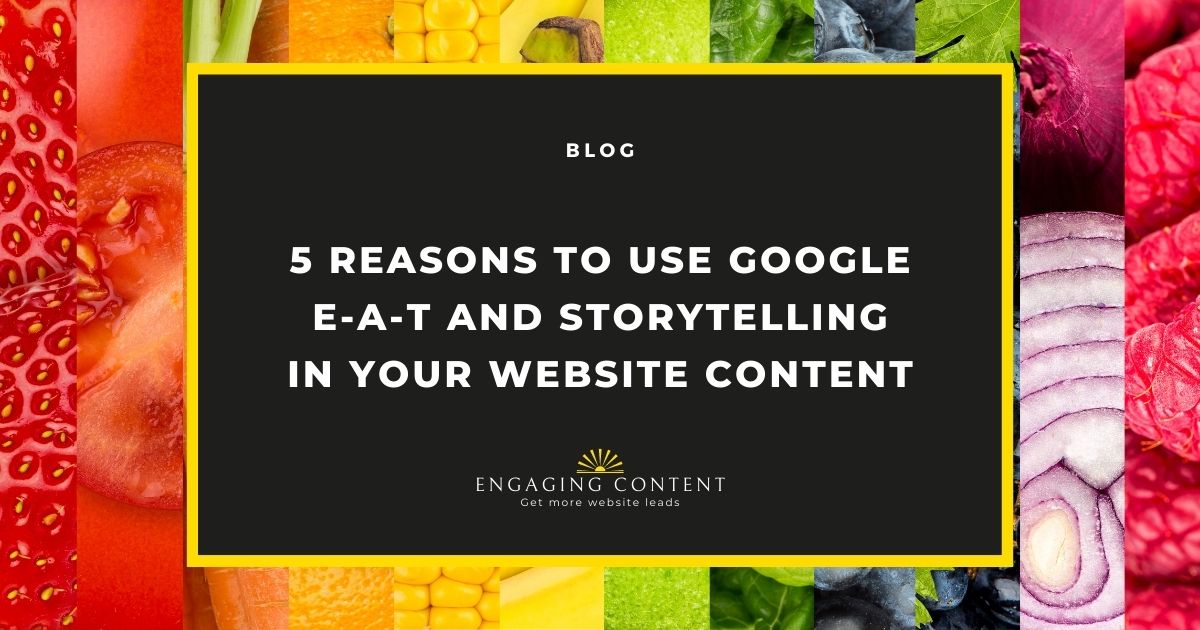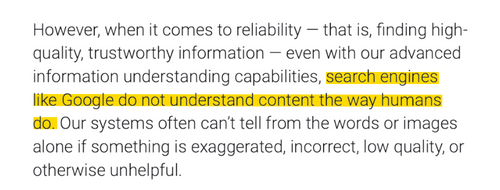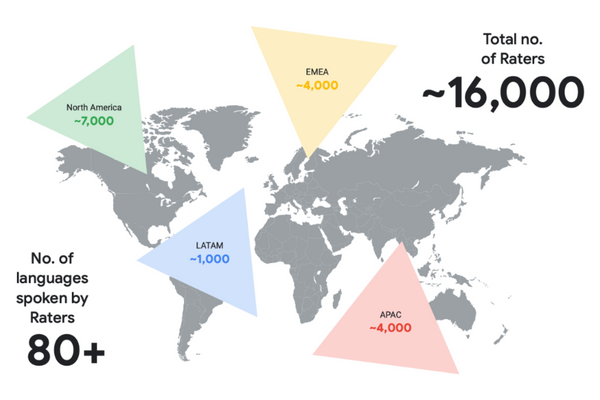Introduction
With the uprising of AI content tools like Chat GPT and Bard, it is now even easier to create website content.
The downside of the potential influx of more content is that it could be duplicated and appearing on other websites. This will confuse both the human and the algorithm and raises questions:
- How does the content stand apart?
- Is it plagiarised, and which version should be trusted?
- Who owns the content?
In this blog, I will introduce and explain Google EAT. What it was, what it became, why it is important and what you need to know.
And the 5 reasons to use Google E-A-T and storytelling in your website content to appeal to your audience and improve your organic search visibility.
But first…
WHAT IS GOOGLE EAT?
Google E-A-T stands for expertise, authority, and trustworthiness.
It is a set of criteria used by Google to assess the quality and relevance of website content. The higher a website ranks on these criteria, the higher it will rank on search engine results pages (SERPs).
And whilst the algorithm is intelligent Google admits it can’t understand content the way a human can ⤵
Source: Google Search Quality Rater Guidelines
Highlighted in Google’s Search Quality Rater Guidelines, E-A-T stands for:
- Expertise refers to the level of knowledge and experience that the content creator or website has in their field and chosen subject matter.
- Authority refers to the reputation of the website and the content creator within the industry or niche.
- Trustworthiness refers to the level of reliability and honesty of the content creator and the website in terms of providing accurate information or products/services.
In essence, Google uses E-A-T to evaluate the quality and relevance of the content on a website to determine its rankings in search results
Websites with high levels of E-A-T are more likely to rank well in search results than those without.
❌ E-A-T isn’t a metric you can track.
❌ It’s not an algorithm.
✅ It’s a principle that informs the algorithm.
Google uses real people as quality raters from all over the world who check for a range of criteria against Google’s Search Quality Rater Guidelines to evaluate the quality of a website’s content.
Raters then provide feedback on how to improve Google’s search algorithm, with the aim of providing searchers with a better user experience. This isn’t:
- subjective work based on opinion, or
- objective based on an algorithm
it is relative compared to the other content out there.
Source: Google Search Quality Rater Guidelines
ADDING ANOTHER E: GOOGLE E-E-A-T
In a recent update to the Search Quality Rater Guidelines Google included another E to its standard E-A-T. It stands for Experience making the acronym become Google E-E-A-T.
This is in response to the AI-generated content that is now possible to create easily using tools such as Chat GPT and Bard.
Not all content is created equal
The problem is that not all content is created equal. It is one thing to have knowledge on a subject and be expert at explaining it, it is entirely another thing to apply that knowledge to the real world using experience.
For example, a teacher will know the theory and have the knowledge about a specific topic but they won’t necessarily have worked in this field of expertise.
Compare this to someone who has worked in the field and applied their knowledge daily to execute their job. They could share their experience in a more compelling way such as:
✅ Telling their back story to highlight their passion for their work.
✅ Telling a customer success story and the transformation achieved.
✅ Sharing results using case studies with statistics and feedback.
💛 So this update places trust at the heart of Google’s E-E-A-T concept.

STORYTELLING CREATES TRUST
Experience is also another word for story
Analogies are great and help to clarify a concept by comparing it to an existing idea. But there is nothing like a real-life experience to deliver the message.
Rewrite using storytelling
We know AI tools and machines can’t mimic experience but they do help to speed up the task at hand. HOW you USE the tool and what you put into it will determine its output and effectiveness. So use tools like Chat GPT as a way to map and outline your content and rewrite using storytelling to demonstrate your experience.
First-hand experience
The trustworthiness of your website and content is supported by your first-hand experience of you, the content creator and your expertise, over your website’s authority and reputation within the industry. If someone writes a review, have they used the product or service? How credible is that review? If someone publishes a recipe, how do we know they made the dish before? Including a photo of you with your creation will help to improve trust.
Let me tell you a story…
Recently I bought an air fryer
Turned out to be a timely purchase, given that my main oven decided to stop working. As a tool, the Ninja air fryer is simple to use. So I launched head first into trying it out and a few charcoal chicken legs later, I realised I needed to stop and take a step back from rushing to use it and ending up with inedible food. So yes as a tool it was great, and simple but what you put into it and how you use it makes a difference to the output. In an ideal world we would sit and read the manual but I am a bit impatient, ‘what’s the worse that could happen’ I thought. But with a bit of slowing down, and a bit of Googling, the sweet potato fries were delicious, healthy and fried (not burnt!)
Besides, everyone loves a good story…
As humans, we thrive on connection and so reading a personal experience adds that missing piece to the content. Plus it also makes the content more trusted and authentic because the creator has shared the story in a better way.

With all of the above in mind – let’s get practical. Here are the 5 reasons to use Google EAT and storytelling in your website content:
#1 Creates more trustworthy, unique content
Quality content should be accurate and complete in its coverage of the topic and easy to read and understand but also unique and not duplicated.
- Credible sources
Content needs to be well-researched, informative, and backed up by credible sources. - Make your content unique
Use AI tools help to map out your content more quickly but remember that they produce duplicated content, essentially a copy-paste of information. So ensure you make your content unique. - Earn high-quality backlinks
Earn high-quality backlinks from reputable and authoritative websites in your niche will help to signal to Google that your website is a trustworthy and reliable source of information.

#2 Builds your online reputation
The trustworthiness of your website – which is at the heart of the E-E-A-T principle – relies on the idea that behind the content is a person that searchers can relate and engage with.
- Re-write your content
Use AI tools as a guide but exercise caution, do your research and re-write your content in your own unique brand voice, and experience and use storytelling. - Be transparent
Be transparent about your identity by clearly displaying your contact information, a recent photo. Include your business contact information and background. This can help to establish trust with your audience. - Get reviews and encourage user-generated content
Cultivate a positive online reputation through online reviews, testimonials, and social media mentions. This can help to establish your website’s reputation and authority. Encourage customers to leave reviews and engage with your audience on social media to build a positive online presence. Lean into user-generated content where your customers share their experience directly with their audience. - Demonstrate expertise in your niche. Establish yourself or your business as an expert in your niche or industry. This can be achieved by creating in-depth and informative content, publishing research studies or white papers, and providing expert insights or commentary on industry news. and remember to include the stories!

#3 Improves the user experience of your website
Google’s algorithm favours websites that provide an improved user experience.
- Make navigation easy
Ensure that your website is easy to navigate, loads quickly, and provides a positive experience for your users. Keep your clicks to a maximum of three deep. - Ensure your content reads well
Your content should also be optimised for readability. This is the extent to which your readers can easily understand the information on your website. There are free AI apps such Hemingway to help improve readability and Grammarly to remove those pesky spelling mistakes! - Make your content easy to scan
Scannability is the ease with which users can find essential pieces of information in your content without having to read the entire page. This create a more intuitive user experience, and increases dwell time on your pages which signals to Google that your content is hitting the mark for the user. Think lists, images and headings as a way to break up your content.

#4 Helps you stand out from the competition
Having competition is positive. But ultimately people buy people. So create quality content that is relatable and relevant to your audience to help you to stand out from the competition.
- Get a professional photo shoot
A picture speaks a thousand words. Invest in some quality photos of you that you can use in your website and social media so that you are front and centre of your brand. - Use video
As a personal brand, don’t hide behind – show your face on your home and about page. Include video of you demonstrate your expertise and experience. This will help to bring everything alive and create a connection more quickly. - Tell stories
Storytelling makes your content engaging and improves the user experience. As humans we have evolved with stories and engage with content that gives us a reason to invest in it. Through storytelling, you can walk your users through your experience while also demonstrating expertise, which builds the authority and trustworthiness of your website.

#5 Helps SEO and ranking in the SERPs
We already know that following the E-E-A-T principle is a good way to set the standard of your content and that Google will prioritise website content that demonstrates expertise, experience, trust and authority in your niche or industry.
- Answer questions
Make content valuable – answer questions, provide helpful tips, give users accurate, detailed and compelling content each and every time. - Use outbound linking
Included outbound links to other relevant websites which are already considered trusted sources will help to boost your SEO rankings.
The more authoritative and credible your content, the higher your website is likely to rank well for relevant search queries.

Conclusion
In the world of content, SEO is an important part of any website’s success. By incorporating the principles of Google E-A-T and human storytelling into your content you can ensure your content is not only compelling, but also credible, authentic, and more importantly unique. So if your website provides quality content according to the Google EAT principle, the chances are your website will rank well. And using the additional E of Google E-E-A-T with real-life experience will ensure the human aspect of your content is prioritised over machine-generated content.




